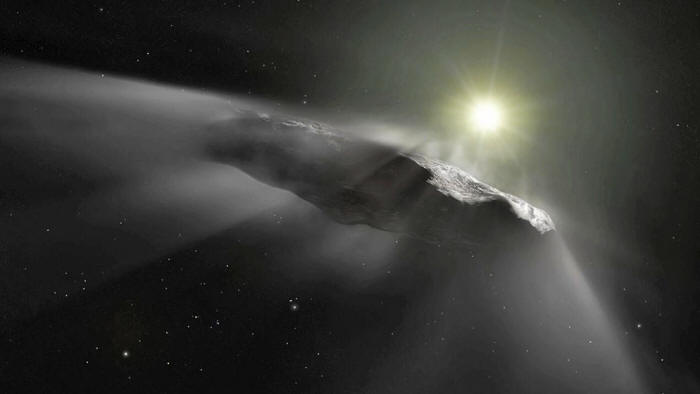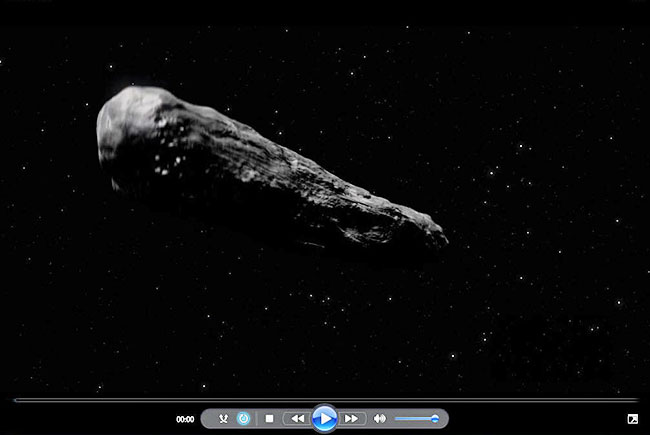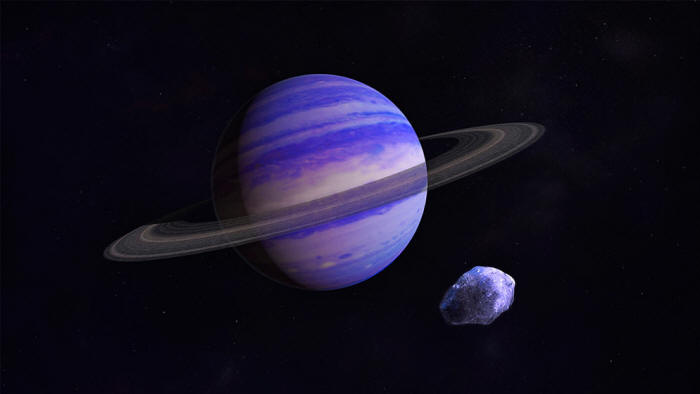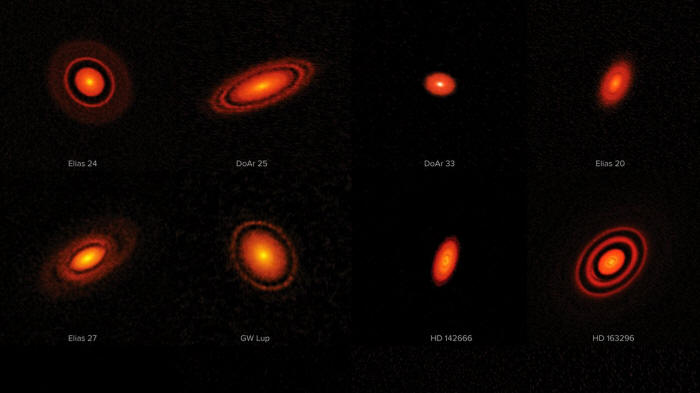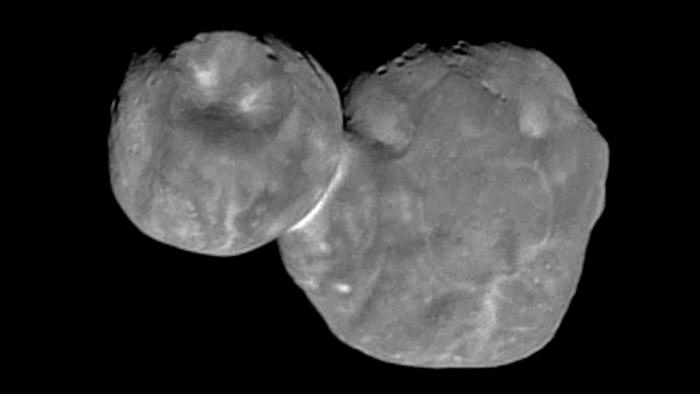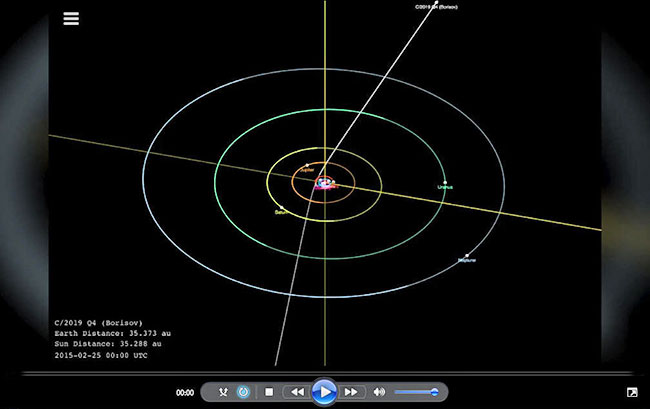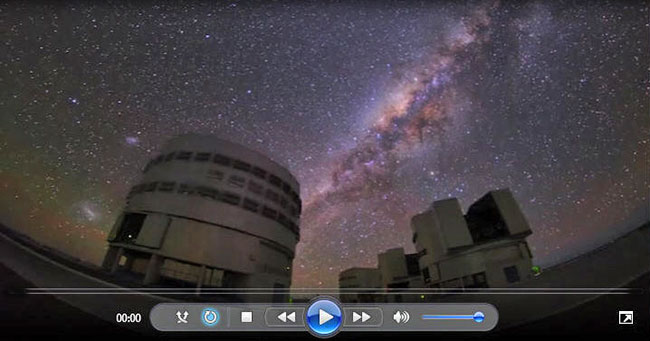|
from Space Website
of the interstellar object 'Oumuamua. (Image credit: ESA/Hubble, NASA, ESO, M. Kornmesser)
Although its origins are still hazy, interstellar objects like 'Oumuamua may be the product of wandering planets in young planetary systems...
If true, then the
population of such rogue objects moving between the stars could be
in the
hundreds of trillions of trillions (that's a digit followed
by some 26 zeroes).
In fact, interstellar interlopers such as 'Oumuamua and Borisov, the only two discovered so far, had been predicted long before.
Insterstellar Object 'Oumuamu's Flight Through Our Solar System - Animation
New European Southern Observatory observations of recently discovered interstellar object 1I/2017 U1 (`Oumuamua) has revealed an unusual shape Credit: ESO, M. Kornmesser, L.Calcada. Music: Azul Cobalto
In 2005 astronomers proposed the "Nice model," so named because the astronomers who developed it worked at the Observatoire de la Côte d'Azur in Nice, France.
The Nice model
depicts how interactions within a rich disk of asteroids and comets
prompted Saturn, Uranus and Neptune to migrate outward and Jupiter
to migrate inward slightly over hundreds of millions of years.
But according to Laughlin, in the context of interstellar objects, it doesn't matter which model is right.
The throw line, in turn, is located where a giant planet is able to slingshot a small body with enough acceleration to achieve escape velocity from the gravitational pull from its star.
The farther out the
planet is, the easier this becomes because the star's gravity
decreases with radial distance.
a Neptune-like exoplanet and an icy planetesimal.
(Image
credit: NASA/Goddard/Francis Reddy)
As the most distant planet that orbits in a region where the escape velocity is low and there are plenty of icy bodies to throw around, Neptune would have acted as the solar system's bouncer as the planet migrated outward, ejecting many of the small bodies that got in its way.
...adding that there is observational evidence to support this, in the form of images taken by ALMA, the Atacama Large Millimeter/submillimeter Array, of planet-forming disks of dust around young stars.
Many of these disks
appear to have ring-shaped gaps in them that may have been cleared
out by the gravity of Neptune-like worlds. Examples of protoplanetary disks with rings carved, probably, by planets. These images were produced as part of ALMA's DSHARP (Disk Substructures at High Angular Resolution Project) survey. (Image credit: ALMA (ESO/NAOJ/NRAO)/ S. Andrews et al/NRAO/AUI/NSF/S. Dagnello)
These worlds cannot eject small bodies into interstellar space because the escape velocity that close to their star is too great.
Furthermore, these
systems with hot giant planets are very unlike our own solar system,
whose innermost worlds are small, rocky and comparatively far from
the sun.
We have seen a somewhat
similarly-shaped body in the form of
Arrokoth, the Kuiper Belt
object that NASA's
New Horizons spacecraft flew past on New Year's
Day 2019. of the Kuiper Belt object dubbed Arrokoth. (Image credit: NASA /Johns Hopkins University Applied Physics Laboratory/ Southwest Research Institute)
In addition, 'Oumuamua didn't have a comet's signature coma, the "atmosphere" around the comet's main body.
Unconventional explanations aside, one hypothesis that Laughlin likes is the idea that 'Oumuamua was a chunk of solid hydrogen ice.
The only location where such an object could form would be in the cold core of a dense molecular cloud of gas.
Such clouds, once they are gravitationally destabilized, become the birthplaces of stars, but are they cold enough to form a chunk of solid hydrogen like 'Oumuamua?
The theory suggests that 'Oumuamua would have formed inside a molecular cloud as a much larger object that became whittled down over time.
Laughlin likes to draw the analogy of a bar of soap, which begins life as thick block, but after numerous washes it reduces to a thin oblate sliver - the same shape as 'Oumuamua.
Molecular hydrogen freezes at about 14 kelvin - that's 14 degrees above absolute zero, or minus 434 degrees Fahrenheit (minus 259 degrees Celsius).
The cores of molecular clouds can reach similar temperatures, but the conditions would have to be just right for the hydrogen to condense quickly into a solid, and it’s not clear how regularly those conditions occur.
However, if they are common, then,
One piece of supporting evidence for this lies in 'Oumuamua's path through space before it arrived at our solar system.
Astronomers have traced it back and found that, 45 million years ago, 'Oumuamua would have been in the same spot where a giant molecular cloud would have been about to form the stars of the Carina moving group.
See Insterstellar Comet Borisov's Orbit - Animation
The European Southern Observatory used many of its telescopes to study 1I/'Oumuamua and 2I/Borisov, the first interstellar objects humanity has discovered flying through our solar system.
A dearth of
interstellar objects
Do astronomers find it
surprising that besides 'Oumuamua and Borisov, we have yet to
discover any other interstellar interlopers?
However, Jewitt admits that he was surprised that Borisov came along so quickly after 'Oumuamua, and is,
Laughlin is still clinging to the most optimistic scenario regarding the numbers of interstellar interlopers, but only just.
The current dearth of interstellar objects,
Based on the current
discovery rate of just two in five years, he said that current
estimates of the abundance of such objects should be halved.
Interstellar objects 'Oumuamua and Borisov studied by European observatories
The European Southern Observatory used many of its telescopes to study 1I/'Oumuamua and 2I/Borisov, the first interstellar objects humanity has discovered flying through our solar system. Credit: ESO
However, the Vera C. Rubin Observatory in Chile will begin observing by the middle of this decade.
With its 8.4-meter,
wide-field survey telescope, it will embark on the Legacy Survey
of Space and Time (LSST) and, if predictions hold true, it is
expected to discover at least one interstellar interloper every
year.
With the James Webb Space Telescope now up and running, astronomers have a powerful tool for studying these objects that wasn't available when 'Oumuamua was cutting its course through the solar system.
|


